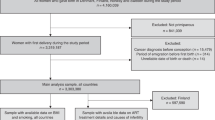Abstract
Objective: A recent analysis suggested that ovarian cancer risk increased with time since last birth, possibly because of some aspect of pregnancy that affects the clearance of cells that have undergone malignant transformation. We analyzed data from four case–control studies pertaining to ovarian cancer risk in relation to age at first pregnancy, age at last pregnancy, and years since last pregnancy: 628 cases and 3432 neighborhood or population controls, ages 18–79, were included.
>Methods: We used logistic regression to analyze associations between ovarian cancer risk, controlling for study, age (at diagnosis or corresponding reference age for controls), race, parity, oral contraceptive use, tubal ligation, family history of ovarian or breast cancer, and excluding women with a history of infertility.
Results: An early age at first pregnancy was associated with an increased risk of ovarian cancer (odds ratio 1.4, 95% confidence interval (1.1–1.8) for ages ≤19 compared to ≥25). Years since last pregnancy was also associated with increased ovarian cancer risk, with odds ratios of 1.4, 1.4, 1.8, and 2.1 for 10–14, 15–19, 20–24, and ≥25 years compared to 0–9 years (trend test p = 0.004), respectively.
Conclusion: These observations support the results from the previous study, and raise additional questions about the role of pregnancy in the etiology of ovarian cancer.
Similar content being viewed by others
References
Whittemore AS, Harris R, Itnyre J (1992) Collaborative Ovarian Cancer Group. Characteristics relating to ovarian cancer risk: collaborative analysis of 12 case-control studies. II. Invasive epithelial ovarian cancers in white women. Am J Epidemiol 136: 1184-1203.
Negri E, Franceschi S, Tzonou A, Booth M, La Vecchia C, Parazzini F, Beral V, Boyle P, Trichopoulos D (1991) Pooled analysis of 3 European case-control studies: 1: Reproductive factors and risk or epithelial ovarian cancer. Int J Cancer 49: 50-56.
Adami HO, Hsieh CC, Lambe M, Trichopoulos D, Leon D, Persson I, Ekbom A, Janson PO (1994) Parity, age at first childbirth, and risk of ovarian cancer. Lancet 344: 1250-1254.
Fathalla MF (1971) Incessant ovulation — a factor in ovarian neoplasia? Lancet 2: 163.
Cramer DW, Welch WR (1983) Determinants of ovarian cancer risk. II. Inferences regarding pathogenesis. J Natl Cancer Inst 71: 717-721.
Whittemore AS, Harris R, Itnyre J (1992) Collaborative Ovarian Cancer Group. Characteristics relating to ovarian cancer risk: collaborative analysis of 12 case-control studies. IV. The pathogenesis of epithelial ovarian cancer. Am J Epidemiol 136: 1212-1220.
Cooper GS (1995) Childbearing and risk of ovarian cancer. Lancet 345: 317-318.
Albrektsen G, Heuch I, Kvåle G (1996) Reproductive factors and incidence of epithelial ovarian cancer: a Norwegian prospective study. Cancer Causes Control 7: 421-427.
Whittemore AS, Harris R, Itnyre J, Halpern J (1992) Collaborative Ovarian Cancer Group. Characteristics relating to ovarian cancer risk: collaborative analysis of 12 case-control studies. I. Methods. Am J Epidemiol 136: 1175-1183.
Casagrande JT, Pike MC, Ross RK, Louie EW, Roy S, Henderson BE (1979) “Incessant ovulation” and ovarian cancer. Lancet 2: 170-173.
Cramer DW, Hutchison GB, Welch WR, Scully RE, Ryan KJ (1983) Determinants of ovarian cancer risk. I. Reproductive experiences and family history. J Natl Cancer Inst 71: 711-716.
The Cancer and Steroid Hormone Study of the Centers for Disease Control and the National Institute of Child Health and Human Development. (1987) The reduction in risk of ovarian cancer associated with oral contraceptive use. N Engl J Med 316: 650-655.
Wu ML, Whittemore AS, Paffenbarger RS Jr, Sarles DL, Kampert JB, Grosser S, Jung DL, Ballon S, Hendrickson M, Mohle-Boetani J (1988) Personal and environmental characteristics related to epithelial ovarian cancer. I. Reproductive and menstrual events and oral contraceptive use. Am J Epidemiol 128: 1216-1227.
Godard B, Foulkes WK, Provencher D, Brunet JS, Tonin PN, Mes-Masson AM, Narod SA, Ghadirian P (1998) Risk factors for familial and sporadic ovarian cancer among French Canadians: a case-control study. Am J Obset Gynecol 179: 403-410.
O'Leary P, Boyne P, Flett P, Beilby J, James I (1991) Longitudinal assessment of changes in reproductive hormones during normal pregnancy. Clin Chem 37: 667-672.
Rodriguez GC, Walmer D, Lessey B, Cline M, Krigman HR, Hughes CL (1998) The effect of contraceptive progestin on the ovarian epithelium: cancer prevention through apoptosis. J Soc Gynecol Invest 5: 271-276.
Bu SZ, Yin DL, Ren XH, Jiang LZ, Wu ZJ, Gao QR, Pei G (1997) Progesterone induces apoptosis and up-regulation of p53 expression in human ovarian carcinoma cell lines. Cancer 79: 1944-1950.
Chan LN, Zhang S, Cloyd M, Chan TS (1997) N-(4-hydroxyphenyl) retinamide prevents development of T-lymphomas in AKR/J mice. Anticancer Res 17: 499-503.
Inada T, Ichikawa A, Kubota T, Ogata Y, Moossa A, Hoffman RM (1997) 5-FU-induced apoptosis correlates with efficacy against human gastric and colon cancer xenografts in nude mice. Anticancer Res 17: 1965-1971.
Risio M, Lipkin M, Newmark H, Yang K, Rossini FP, Steele VE, Boone CW, Kelloff GJ (1996) Apoptosis, cell replication, and Western-style diet-induced tumorigenesis in mouse colon. Cancer Res 56: 4910-4916.
Author information
Authors and Affiliations
Corresponding author
Rights and permissions
About this article
Cite this article
Cooper, G.S., Schildkraut, J.M., Whittemore, A.S. et al. Pregnancy recency and risk of ovarian cancer. Cancer Causes Control 10, 397–402 (1999). https://doi.org/10.1023/A:1008960520316
Issue Date:
DOI: https://doi.org/10.1023/A:1008960520316




